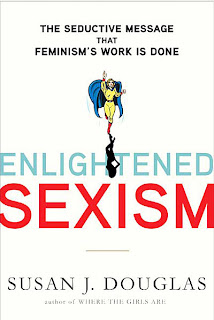 |
| Enlightened Sexism: The Seductive Message that Feminism’s Work is Done by Susan J. Douglas |
Note: all boldface is my emphasis, not the author’s.
Today, feminist gains, attitudes, and achievements are woven into our cultural fabric. So the female characters created by Shonda Rhimes for Grey’s Anatomy, to choose just one example, reflect a genuine desire to show women as skilled professionals in jobs previously reserved for men. Joss Whedon created Buffy the Vampire Slayer because he embraced feminsim and was tired of seeing all the girls in horror films as victims, instead of possible heroes. But women whose kung fu skills are more awesome than Jackie Chan’s? Or who tell a male coworker (or boss) to his face that he’s less evolved than a junior in high school? This is a level of command-and-control barely enjoyed by four-star generals, let alone the nation’s actual female population.But the media’s fantasies of power are also the product of another force that has gained considerable momentum since the early and mid-1990s: enlightened sexism. Enlightened sexism is a response, deliberate or not, to the perceived threat of a new gender regime. It insists that women have made plenty of progress because of feminism–indeed, full equality has allegedly been achieved–so now it’s okay, even amusing, to resurrect sexist stereotypes of girls and women. After all these images (think Pussycat Dolls, The Bachelor, Are You Hot?, the hour-and-a-half catfight in Bride Wars) can’t possibly undermine women’s equality at this late date, right? More to the point, enlightened sexism sells the line that it is precisely through women’s calculated deployment of their faces, bodies, attire, and sexuality that they gain and enjoy true power–power that is fun, that men will not resent, and indeed will embrace. True power here has nothing to do with economic independence or professional achievement (that’s a given): it has to do with getting men to lust after you and other women to envy you. Enlightened sexism is especially targeted to girls and young women and emphasizes that now that they “have it all,” they should focus the bulk of their time and energy on their appearance, pleasing men, being hot, competing with other women, and shopping.
Enlightened sexism is a manufacturing process that is produced, week in and week out, by the media. Its components–anxiety about female achievement; a renewed and amplified objectification of young women’s bodies and faces; the dual exploitation and punishment of female sexuality; the dividing of women against each other by age, race, and class; rampant branding and consumerism–began to swirl around in the early 1990s, consolidating as the dark star it has become in the early twenty-first century. Some, myself included, have referred to this state of affairs and this kind of media mix as “postfeminist.” But I am rejecting this term. It has gotten gummed up by too many conflicting definitions. And besides, this term suggests that somehow feminism is at the root of this when it isn’t–it’s good, old-fashioned, grade-A sexism that reinforces good, old-fashioned, grade-A patriarchy. It’s just much better disguised, in seductive Manolo Blahniks and an Ipex bra.
Susan J. Douglas is the author of Where the Girls Are, The Mommy Myth
, and other works of cultural history and criticism. Her work has appeared in The Nation, The Progressive, Ms., The Village Voice, and In These Times. (taken from the jacket cover of Enlightened Sexism)
